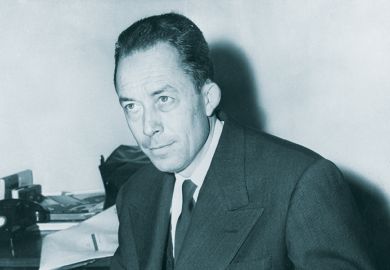Living to Tell the Tale is the first of three volumes that when completed will constitute the memoirs of one of the most respected and widely read prose writers of Latin America. Only the flawlessly bilingual Carlos Fuentes can share the dais with "Gabby", and even he cannot summon the mischievous tone and sense of humour that the creator of Macondo possesses in such abundance.
The eagerly awaited memoirs arrived with the ballyhoo befitting the assertion made on the flyleaf that this was the world's greatest living novelist. Truly impressive was the fact that Knopf, before publishing this competent English translation by Edith Grossman, brought out an edition in Spanish that turned into a bestseller in the US. This was a first for trade book publishing and suggests, at the very least, the growing market for Spanish-language books in the US.
Volume one takes the reader from early memories of parents and childhood - Gabriel García Márquez was the oldest of 11 children - through secondary education and the beginning of his career as a journalist, the rejection by Editorial Losada of his early manuscripts, and a letter proposing to his future wife. García Márquez's passion for reading and writing is notable for its interest in James Joyce's Ulysses and William Faulkner's novels, from which, it is now common knowledge, he drew on for the structure of his epic, One Hundred Years of Solitude . Like Spanish writers of the Generation of '98 who rebelled against the elderly José Echegaray, the young Colombian and his cohorts rejected the flowery prose of Guillermo Valencia by touting Juan Ramón Jiménez's Platero and I and joining a group called "Stone and Sky", two themes prominent in Jiménez's poems. From many points of view, life in Colombia was still in the 19th century. "Lugubrious" was an adjective García Márquez never separated from Bogotá. He and his fellow journalists spoke fondly of "Old Lady Woolf," who wrote Mrs Dalloway , and "Old Man Faulkner," responsible for As I Lay Dying .
On January 5 1950, he published his first piece in El Heraldo under the pseudonym of Septimus, which was taken from Mrs Dalloway . The Greek chorus of As I Lay Dying was reduced to three in preparation for One Hundred Years of Solitude - the grandfather, the mother, the boy. Many works he literally read forwards and backwards, and he tells us he used his library as a working tool. The result is a kind of low-key marginalia that reveals much about the literary context of García Márquez's work but has little of the compelling urge of his fiction.
In this period of fascination with Anglo-American fiction, his friends urged the canonical Don Quixote on him. It had to be assimilated in García Márquez's own way. The long learned speeches of the knight bored him, Sancho's stupidities did not amuse. Finally he hit upon the idea of reading the novel in the bathroom while attending to his needs. Then the novel became a "conflagration". In One Hundred Years of Solitude , Aureliano Buend!a is an adventurer, a tinkerer, a builder whose curiosity leads him to do wonderfully quixotic things, such as building the largest house in the region and leaving the daguerrotype set up in the parlour 24 hours a day in case God should happen by. A photograph would close one of history's longest discussions, the existence of God.
García Márquez's considerable narrative gift runs the gamut from Hemingway-like short stories to the rich chaos of One Hundred Years of Solitude . In One of these Days , a liberal village dentist comes face to face with the conservative village mayor, who is seeking relief from fierce toothache. Without using anaesthesia, the dentist extracts the mayor's abscessed tooth, looks at the sweating face of his patient and remarks: That will pay for 20 of us you killed, rinse your mouth with salt water. "Who gets the bill," the dentist wants to know, "You or the city?" "It's the same damn thing," declares the police chief, underlining decades of the Colombian civil war in which it matters not who wins.
Nothing could be further from these stories than the history of Macondo, the village in One Hundred Years of Solitude , told with a mixture of chronological time and mythical time that has been called magic realism.
García Márquez's may have learnt a great deal about uses of time and space during his reading of Anglo-American writers, but the voice that carries the tales is his alone. In his memoirs, he recalls the celebration in Bogotá of the end of the Second World War. Flags and speeches filled the city square. Someone asked for a volunteer and, without hesitating, Gabby went out on the balcony and praised Franklin Delano Roosevelt, a short time dead, who, like El Cid, knew how to win battles after death. The bon mot spread throughout the city; García Márquez's first success was, he points out, not as a poet or as a novelist, but rather as an orator.
Mamá Grande's Funeral owes everything to the orator's devices. First, get the audience's attention: "This is, unbelievers of the whole world, the true story of Mam Grande, whose funeral was attended by the Pope himself." Then employ anaphora to establish a narrative thread: "Now that..." Conclude with an invitation no one could resist. Let's have a drink and start to tell the story of the national commotion in all its details before the historians get here.
García Márquez is a raconteur, a person with a special skill in telling stories (not all novelists are raconteurs). The pontiff did visit Latin America, and with him came the historians.
Le Comte de Buffon's (1707-88) famous aphorism is usually quoted out of context: subject matter is external to the man; the man himself is in the style. When we read in One Hundred Years of Solitude that Colonel Buend!a provoked 32 armed uprisings and lost them all, we hear the unmistakable voice of García Márquez getting to Latin America before the historians do.
Howard Young is professor of Romance languages, Pomona College, California, US.
Living to Tell the Tale
Author - Gabriel García Márquez
Publisher - Cape
Pages - 484
Price - £18.99
ISBN - 0 224 078 1
Register to continue
Why register?
- Registration is free and only takes a moment
- Once registered, you can read 3 articles a month
- Sign up for our newsletter
Subscribe
Or subscribe for unlimited access to:
- Unlimited access to news, views, insights & reviews
- Digital editions
- Digital access to THE’s university and college rankings analysis
Already registered or a current subscriber? Login



